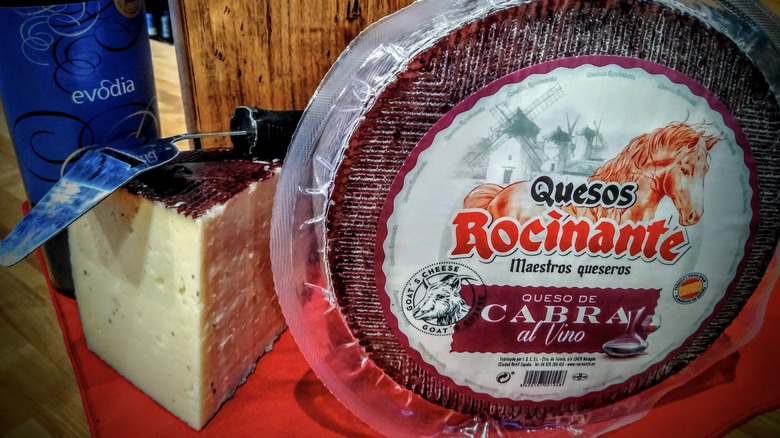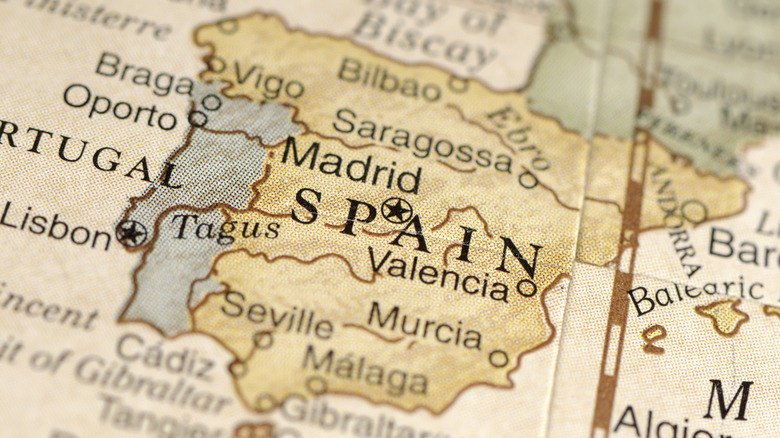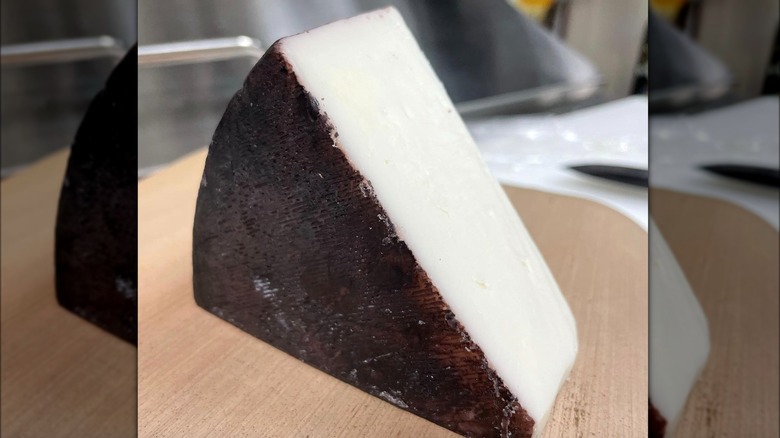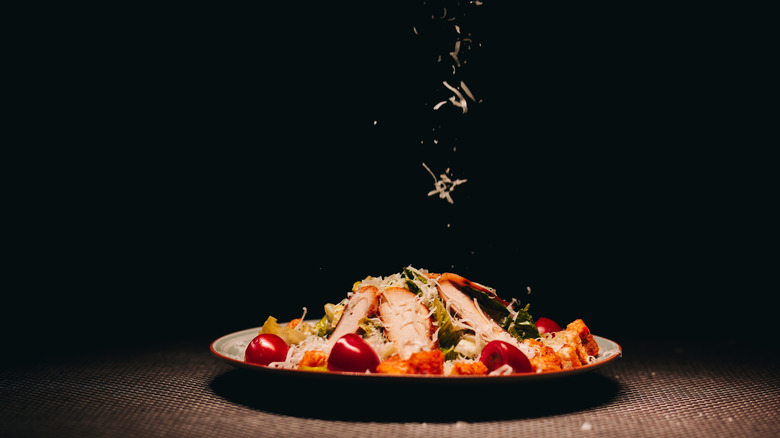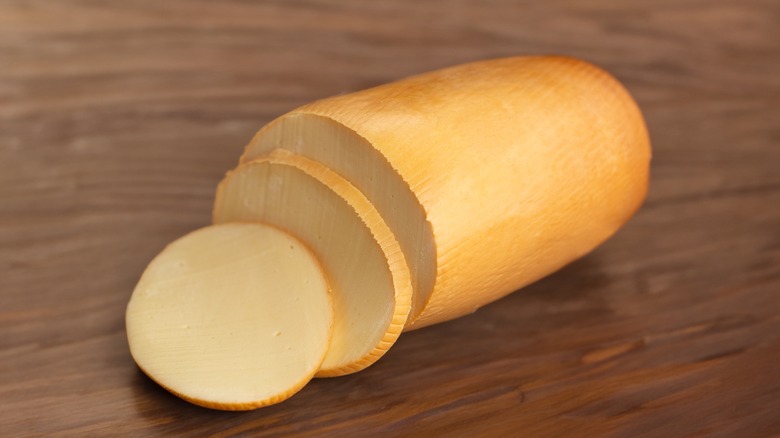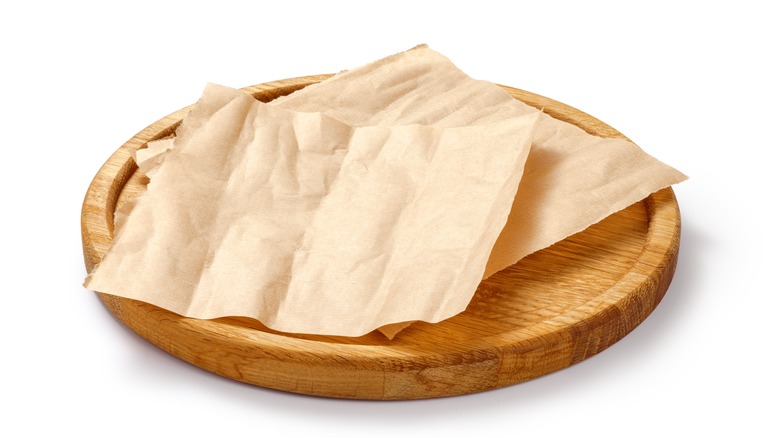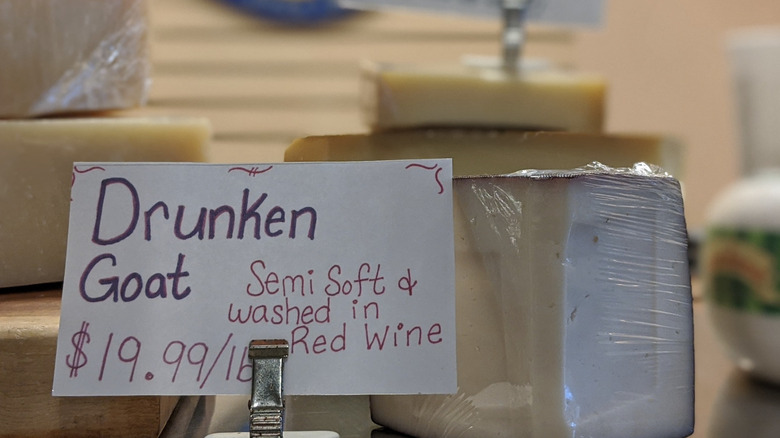Drunken Goat Is The Spanish Cheese That's Soaked In Red Wine
Cheesemaking has evolved greatly from when it first began some 8,000 to 10,000 years ago, resulting in a vast global industry that produces more than 1,800 unique cheese varieties today. From traditional classics like cheddar to more innovative creations with exotic herbs and spices, cheese is an integral part of countless cuisines around the world. One of the more unique options out there is drunken goat cheese.
Manufactured in the Murcia province of southeastern Spain, drunken goat cheese owes its name to its production process. The smooth and creamy cheese is made from pasteurized goat's milk, which is curdled, drained, and then immersed in a bath of red wine. This manufacturing process not only imparts the rind with a vibrant burgundy hue but also infuses the cheese with a subtle, fruity flavor and aroma. The purple rind contributes to the cheese's aesthetic appeal, standing in stark contrast to its ivory-white interior.
Whether served as a part of a cheese board or incorporated into dishes such as pasta or quiche, drunken goat cheese can add a fun twist to any culinary experience. Keep reading to find out more about this Spanish specialty.
The origins of drunken goat cheese
Known as Queso de Murcia al Vino in Spanish, this creamy dairy product is typically produced in the town of Jumilla in Murcia. Notably, the Spanish government has granted Queso de Murcia al Vino a Denomination of Origin status (DO), restricting its production to Murcia. The DO designation also means that to be authentic, drunken goat cheese has to be made from the milk of local Murciano-Granadina goats.
While the exact origins of drunken goat cheese are unknown, goats were brought to Spain around 7,500 years ago, with their milk gradually becoming indispensable to the region's culinary landscape. Over the years, goat milk was turned into cheese, particularly since keeping goats was less labor-intensive than tending to cows. The practice of soaking cheese in wine was probably developed to improve the product's taste, as well as a preservation method. Whatever the exact story, by the time the Middle Ages rolled around, drunken goat cheese was well and truly ingrained in the area's gastronomy.
How is drunken goat cheese made?
The milk of Murciano-Granadina goats is well-suited to cheese production due to its moderate fat and protein content. Once collected, the milk undergoes pasteurization before being blended with rennet and starter culture to create curds. These curds are then fragmented, drained, and pressed into molds to remove any surplus whey. Finally, the newly formed cheese is immersed in containers with red wine.
The dairy is usually soaked in a Murcian red wine that contains double the skins during fermentation, giving it an especially dark color. While this process can take as little as 72 hours, it can also extend to a few weeks, depending on the desired final result. This process imbues the cheese with additional flavor and gives it its distinctive purple rind. After the wine bath, the cheese is taken out to dry before undergoing a weeks-long aging process to achieve the optimal flavor and texture.
What does drunken goat cheese taste and look like?
While goat cheese can vary in flavor, it's typically tart and earthy — a feature that sets it apart from cheeses made from cow's milk. It also comes in different consistencies, ranging from soft to crumbly. Drunken goat cheese stands out from the goat cheese pack due to its smooth and vividly purple rind, a result of being soaked in wine. This eye-catching exterior stands out against the cheese's ivory-colored interior, adding an element of visual appeal to the product. Drunken goat cheese is usually sold in a cylindrical shape, owing to the type of mold used during its production process.
Semi-soft in texture, drunken goat cheese is also exceptionally creamy and smooth. It has a floral and tangy flavor that's milder than that typically associated with goat cheese. This subtler taste profile makes it perfect for people who tend to find goat cheese overly sharp. Aside from adding an aesthetic allure, the purple rind that surrounds the cheese is edible, imparting the overall sensory experience with a touch of fruity flavors and a distinctive whiff of wine.
How is drunken goat cheese eaten?
Perhaps unsurprisingly, drunken goat cheese pairs exceptionally well with a glass of red wine. The synergy between the two is evident, as the fruity and slightly acidic notes of the red wine complement the subtle wine-infused flavor of the rind. Drunken goat cheese also makes a wonderful addition to cheese plates, not only due to its unique flavor but also because it looks exceptional alongside cured meats and artisanal bread — let's just say, it's all about the contrast between the white cheese and vividly-colored rind.
More than just a snack, drunken goat cheese can be utilized in a variety of dishes. It's great for crumbling over salads and pizzas, as well as incorporating into sandwiches. It can also be used to elevate pasta dishes, no matter how easy or complex the recipe. Drunken goat cheese is equally impressive in savory and sweet baked goods, such as tarts, quiches, and cheesecakes.
What are the best substitutes for drunken goat cheese?
Unless you live in Spain where the cheese is produced, drunken goat cheese can be a little tricky to find. Not to worry, however, because several other cheeses can serve as substitutes for the real thing. One alternative is to opt for your standard everyday goat cheese, considering it has a similar flavor and texture. Of course, the ordinary one doesn't come with the unique purple rind of drunken goat cheese.
Several other cheeses can be used instead, including queso fresco and feta. Crumbly and tangy, they can be easily sprinkled over your salad and pasta creations. Other mild semi-soft cheeses that can be used as alternatives for drunken goat cheese include mozzarella and provolone, though the taste will be subtler.
Perhaps the most similar alternative is formaggio ubriaco. Produced in Treviso, Italy, the cheese is bathed in containers of red wine and grape skins. Just like with drunken goat cheese, this technique infuses the cheese with distinctive flavors and aromas from the wine, creating a colorful rind in the process. The big difference between drunken goat cheese and formaggio ubriaco is that the former is made with goat milk and the latter is made with cow milk.
How should drunken goat cheese be stored?
Cheese is a perishable product that can spoil relatively quickly if not stored correctly, leading to food waste and potential health risks. Conversely, proper storage that protects the cheese from exposure to moisture, air, and extreme temperatures can preserve both its quality and flavor. It can also prevent it from absorbing unwanted odors in the refrigerator.
Just like other cheeses, properly storing drunken goat cheese can preserve its shelf life, ensuring that it remains flavorful and safe to eat. It's important to keep it refrigerated and store it in the humidity drawer for best results. You'll want to avoid storing cheese near the freezer as this area of the fridge can get pretty cold.
Once you've opened the cheese, wrap it in parchment or wax paper and cover it with a layer of plastic wrap or foil to prevent it from drying out. Alternatively, you can pop the cheese in an airtight container. If stored properly, drunken goat cheese should be good to eat for two to three weeks. Although it can be frozen, it isn't recommended as it is likely to affect its texture. Still, if you want to use it in cooking, this shouldn't be a problem.
Where can you buy drunken goat cheese?
While drunken goat cheese can be readily purchased in its place of origin, the province of Murcia and most of Spain, it can be harder to find outside of the country. Your best bet is hitting up specialty cheese shops, gourmet food stores, and upscale supermarkets, although we can't guarantee that you'll be successful.
Many online retailers specialize in artisanal cheeses and offer a wide selection, including drunken goat cheese, with options for delivery. These online platforms often provide detailed descriptions, origin stories, and pairing suggestions and recipes for each type of cheese. One of the easiest ways to get your hands on drunken goat cheese is by shopping on Amazon. It isn't cheap, but the platform does offer Murcia drunken goat cheese made in Jumilla, Spain. The cheese is made with local goat milk and wine, so you can rest assured that you're getting an authentic product.
